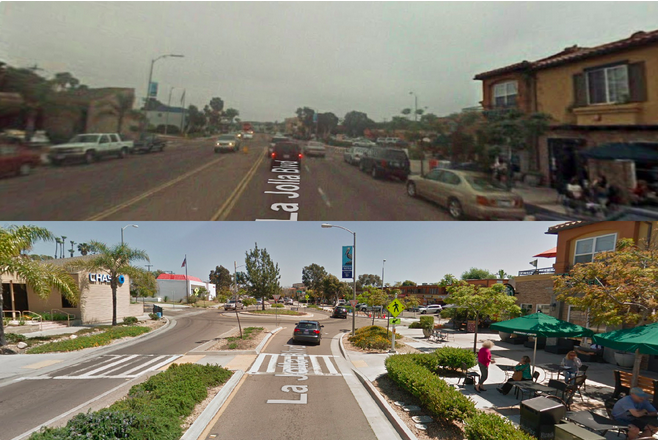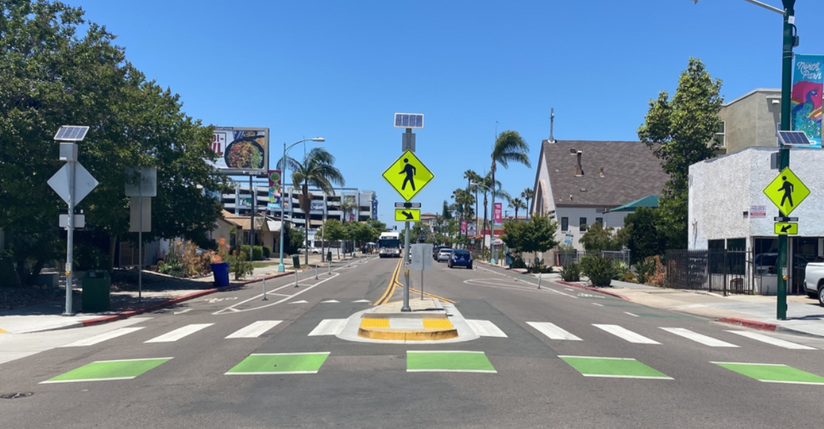The idea had been proposed back in 2021: that San Diego should adopt a Complete Streets ordinance as part of its efforts to combat rising traffic fatalities. In a letter to the city council, a group of bike and safety advocates including Bike SD, Circulate SD, and the San Diego Bicycle Coalition pointed out that the city's Vision Zero strategy was not working, and that street designs meant to address safety took too long to complete.
The letter asked the city for "bold, immediate action to address traffic violence," including speeding up the build-out of its bike network by adding 25 miles of protected bike lanes annually, expediting bike projects, and funding and finishing its mobility action plan. The letter included details about specific places that needed safety improvements, including bike network gaps where riders have been killed.
It also included a request that the city adopt an ordinance to prioritize the movement of people walking, biking, and taking transit instead of just people in cars.
"Such an ordinance would establish standards such as those developed by NACTO as a matter of city policy, rather than being optional implementation by traffic engineers," they wrote. The ordinance, they said, "must direct city staff to identify and convert streets with speed limits of 35 mph or over with sharrows to Class I (separate multi-use paths) or Class IV (protected bike paths) bikeways."
A Draft Policy
Two years later - in July of this year - the city released a draft complete streets policy. This was a triumph, if a slow one, but not exactly what advocates had hoped for.
The draft policy connected the efforts to the city's Climate Action Plan, recognizing that plan's targets to increase walking, biking, and transit. But it is drafted as a policy, not an ordinance that would have the force of law. A policy runs the risk of being treated as a recommendation that can be easily set aside.
Bike SD advocates, spearheaded by board member Nevo Magnezi, began to meet with city staff to suggest ways to strengthen the draft policy, and this was their first point. Many U.S. cities, including Phoenix, Salt Lake City, and Austin, have adopted complete streets ordinances. City staff resisted the suggestion, saying that an update to their street design manual would make it unnecessary.
It smacks just a little bit of Governor Newsom's claim that a statewide complete streets requirement was not necessary because Caltrans already had one. There's a big difference, though, between having a policy and acting on it.
There were other areas that needed improvement as well. The draft policy made no reference to the "gold standard" of street design: the NACTO design guidelines. The city's existing policy "allows" the use of NACTO guidelines, but does not require them to be consulted. Instead, it refers road designers to what are now outdated local standards. This can make using design guidelines worked out by NACTO difficult, as there remain many areas of conflict between them.
BikeSD told city staff that if they were required to follow the NACTO guidance for bikeways, San Diego would be able to meet its mode share goals for biking - eighteen percent by 2035 - after a single cycle of street resurfacing on most city streets.
The best standards already exist, they said. San Diego just needs to use them, not reinvent some of their own.
Words Can Be Twisted
Another concern advocates pointed out was the use of the term "context sensitive design."
"For too long the status quo has been maintained through the euphemism that is 'upholding a neighborhood’s unique character,'” they told staff. "While aesthetic concerns should be considered, they should be secondary to safer streets, economic development, and improved quality of life for all San Diegans."
They pointed to an example in the Bird Rock neighborhood, where local residents initially objected to traffic-calming proposals along La Jolla Boulevard. The city reduced traffic lanes from five to two and added roundabouts and medians in the area. Since implementing the new design, the City reports show a ninety percent decrease in traffic incidents and crashes, and a thirty percent increase in retail sales in the area, according to Project Public Spaces.
"A pertinent question is: was a more dangerous, auto-oriented corridor part of the 'community’s character' prior to the changes? Could someone use that as an argument against more complete streets?" asked advocates.

They recommended removing "verbiage" that referred to "community character" entirely. "A strong neighborhood is one that evolves over time, one that is adaptive to growth. A neighborhood’s unique character should not be an impediment to improvements to safety and mobility."
Staff responded by changing this part of the draft policy to define "context sensitive design" more specifically, to wit: "Design that is flexible and seeks to balance the need to more people efficiently with outcomes specific to each neighborhood's unique context, including topography, roadway alignments, sight distances, and historical resources."
Exemptions
Advocates also had major concerns with the proposed exemption process. Under the draft policy, exemptions would be at the discretion of decision makers and rely on "sound engineering judgment" rather than specific, clearly defined exceptions. There was also no provision for public notice or input. They suggested changes, but these were not incorporated into the final policy, with staff saying that further work on defining the exception process could be done later. Staff also responded that requiring public participation on all decisions was "infeasible."
In the end, city staff incorporated advocates' feedback on the NACTO design standards, on wording about a “neighborhood’s unique character,” on the use of temporary design/quick build elements in capital projects, and on adding a requirement for private developers to adhere to complete streets requirements, including during construction.
The draft policy came to full council in December. The city attorney had made a number of changes, specifically ones that made it much easier to exempt a project. Bike SD and other commenters, including Climate Action Campaign, San Diego County Bicycle Coalition, and Families for Safe Streets SD, spoke up, asking the city to develop a more rigorous exemption process. They suggested a checklist system to require projects seeking exemptions to say whether the project would result in bringing the city closer to reaching its Climate Action Plan goals - or not. They also asked that any requested exemptions include documentation and data backing up the request, and that the public be given an opportunity to weigh in.
Councilmember Kent Lee proposed an amendment to ensure that private developers had to clearly outline any reasons for not complying with the complete streets policy. Councilmember Raul Campillo added an amendment to say that projects should "align with NACTO best practices and guidelines."
The policy was adopted by the council, with these amendments, on December 11, 2023. It's a big win: the first Complete Streets policy for the city of San Diego, clarifying that road designs going forward will be required to consider the needs and safety of everyone using them.
Bike SD's Anar Salayev, who participated in much of the organization's work, responded with the following statement: " While we are happy that the city now has a complete streets policy, incorporated some of our more minor concerns, and that council bolstered wording for private developers and bike facilities, there is a glaring point of failure: City-initiated projects are more or less exempt from having to go through the exemption process," since it merely calls for the city to "make an informed decision" about any exceptions.
Note that the request for the city to convert fast streets with "sharrows" to either multi-use paths or protected bikeways was not included specifically in the policy. However, it looks like sharrows are on their way out of favor, having just been eliminated from the MUTCD - so, one day? Or, in other words: More work needed.






